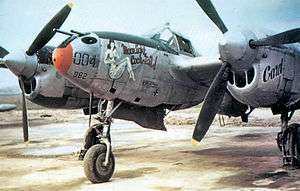IX Tactical Air Command
| IX Tactical Air Command | |
|---|---|
|
367th Fighter Group Lockheed P-38G-10-LO Lightning 42-12982 | |
| Active | 1943-1945 |
| Country | United States |
| Branch | United States Army Air Forces |
| Role | Fighter Command and Control |
The IX Tactical Air Command is an inactive United States Air Force unit. Its last assignment was with the Ninth Air Force, based at Camp Shanks, New York. It was inactivated on 25 October 1945.
History
Formed in England during 1943 as IX Air Support Command (IX ASC). The primary mission of the command was to provide tactical Close Air Support of the United States First Army ground forces to interdict concentration of enemy forces, attack communications and ammunition dumps, and harass the enemy's retreat as well as provide reconnaissance to bombing support.
It was re-designated as IX Tactical Air Command (IX TAC) in April 1944 in England, and its mission initially was attacking enemy forces in Occupied France and the Low Countries in preparation for the Normandy Invasion in June. Targets included bridges, roads, railroads and enemy interceptor aircraft both on the ground as well as in air-to-air combat.
After the D-Day invasion, IX Tactical Thunderbolts attacked enemy targets initially in the Cotentin Peninsula, then supported Operation Cobra, the breakout of Normandy and attacked enemy forces in the Falaise-Argentan Gap. Targets were expanded to include enemy tanks, vehicles of all types, and troop formations. Many times targets of opportunity on the ground were spotted and attacked when seen. Coordinated attacks were made with Allied ground forces and when Allied forces attacked strong enemy defenses, the enemy defenses received machine-gun and attacked by rockets and bombs from the P-47 Thunderbolts. In the air, IX Tactical aggressively sought combat with Luftwaffe aircraft and cleared the skies above the battlefield of enemy aircraft.
Wing headquarters and subordinate units operated primarily from liberated airfields and newly built temporary Advanced Landing Grounds in France, moved into north-central France, its groups attacking enemy targets near Paris then north-west into Belgium and the southern Netherlands. In December 1944/January 1945, engaged enemy targets on the north side of the Battle of the Bulge, then moved eastward into the Northern Rhineland as part of the Western Allied invasion of Germany.
Supported First Army as it crossed the Rhine River at Remagen then moved north to attack ground targets in the Ruhr, providing air support as Allied ground forces encircled enemy forces in the Ruhr Pocket, essentially ending organized enemy resistance in Western Germany. First Army halted its advance at the Elbe River in late April 1945, the wing engaging targets of opportunity in enemy-controlled areas until combat was ended on 5 May 1945.
Remained in Europe after the war as part of United States Air Forces in Europe, performing occupation duty and the destruction or shipment to the United States of captured enemy combat equipment. Assigned units also performed air defense duty over the American Zone of Occupation. Demobilized in Germany in the late summer, inactivated as an administrative unit in the United States during October 1945.
Lineage
- Constituted as IX Air Support Command on 29 November 1943
- Activated on 4 December 1943
- Redesignated IX Tactical Air Command in April 1944
- Inactivated on 25 October 1945
- Disbanded on 8 October 1948
Assignments
- Ninth Air Force, 29 November 1943-25 October 1945
Components
|
|
Stations
|
|
References
![]() This article incorporates public domain material from the Air Force Historical Research Agency website http://www.afhra.af.mil/.
This article incorporates public domain material from the Air Force Historical Research Agency website http://www.afhra.af.mil/.
- Maurer, Maurer (1983). Air Force Combat Units Of World War II. Maxwell AFB, Alabama: Office of Air Force History. ISBN 0-89201-092-4.
- Johnson, David C. (1988), U.S. Army Air Forces Continental Airfields (ETO), D-Day to V-E Day; Research Division, USAF Historical Research Center, Maxwell AFB, Alabama.
External links
- Stars and Stripes, Achtung Jabos! The Story of the IX TAC (World War II Stars & Stripes unit history)

.svg.png)